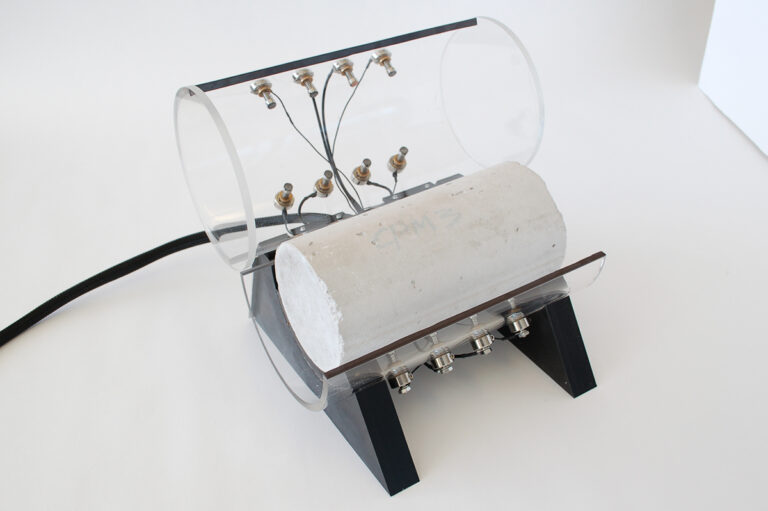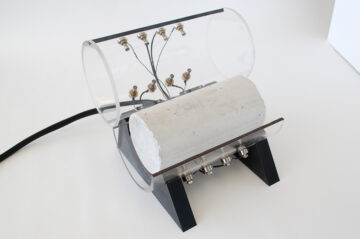Explore 12 Futuristic Technology Trends Solving Concrete's Biggest Challenges.
When it comes to building durable infrastructure, understanding the quality and longevity of concrete is essential. One increasingly popular and effective method for performance-based evaluation is the concrete electrical resistivity test. This technique is gaining traction among researchers and industry professionals for assessing concrete’s durability and ensuring quality control.
Unlike the more time-consuming Rapid Chloride Permeability (RCP) test, electrical resistivity testing is faster, simpler, and offers a more direct correlation to the chloride diffusion coefficient—thanks to the Nernst-Einstein equation. As a result, it’s transforming how engineers evaluate the integrity and long-term performance of concrete structures.
In this blog, we’ll explore the concepts, applications, and measurement techniques involved in concrete electrical resistivity.
What is Electrical Resistivity?
Electrical resistivity refers to the ability of concrete to resist the flow of electrical current. This property is directly linked to the concrete’s pore structure, moisture content, and overall durability. In simple terms, higher resistivity indicates a lower risk of deterioration due to chloride penetration, corrosion, and moisture-related damage.
Why Switch from the RCP Test?
The Rapid Chloride Permeability (RCP) test has been a long-standing method for evaluating concrete durability. However, it is time-consuming and indirect. In contrast, electrical resistivity testing is:
- Faster and easier to perform
- Non-destructive (especially with surface methods)
- Directly related to chloride diffusion
- More consistent for performance-based evaluations
Testing Methods for Concrete Electrical Resistivity
There are two widely used methods to measure the electrical resistivity of concrete:
- Uniaxial (Bulk Resistivity) Method
This laboratory-based test places a concrete cylinder between two metal electrodes. It measures how easily current flows through the entire sample, making it ideal for precise quality control. - Four-Point (Wenner Probe) Method
This field-friendly method involves placing four electrodes on the concrete surface. It’s a quick, non-destructive way to assess electrical resistivity on-site, perfect for existing structures and real-time analysis.
Key Factors That Influence Electrical Resistivity in Concrete
Several variables can affect the accuracy and consistency of electrical resistivity measurements:
- Moisture content: More water results in lower resistivity.
- Temperature: Higher temperatures increase ion mobility, decreasing resistivity.
- Signal frequency: Low frequencies may overestimate results.
- Surface conditions and cracks: Can impact surface measurement accuracy.
Applications of Electrical Resistivity
The versatility of electrical resistivity makes it an invaluable tool in modern construction:
- Chloride Penetration Resistance: Identifies vulnerability to salt attack, especially in coastal or winter climates.
- Diffusion Coefficient Estimation: Helps predict service life by understanding how ions travel through concrete.
- Corrosion Risk Assessment: Higher resistivity correlates with lower corrosion rates of embedded steel.
- Crack Detection: Detects and monitors microcracks affecting durability.
- Setting Time and Moisture Measurement: Useful for optimizing curing and maintenance schedules.
Concrete Electrical Resistivity Standards
The adoption of these techniques into standards and guidelines has been rather slow, with only surface electrical resistivity adopted as a test method by the American Association of State Highway and Transportation Officials (AASHTO TP 95, inactive as of 2025). While ASTM Committee C09 is also developing a standard procedure for evaluating the surface electrical resistivity of concrete, the only resistivity test method that has been standardized to date is ASTM C1760 (withdrawn as of 2025), and this is used for measuring the bulk electrical resistivity. Thus, a gap exists between the state-of-the art knowledge and the current industry practice.
Conclusion
As construction demands grow and durability standards rise, electrical resistivity testing offers a smarter, faster, and more reliable way to evaluate concrete performance. Whether you’re working in the lab or on-site, adopting this method can lead to better decisions, longer-lasting structures, and more efficient quality control.
Want to learn more about electrical resistivity of concrete? Check out this article!
*Editor’s Note: This post was originally published in May 2015 and has since been edited in 2025.










